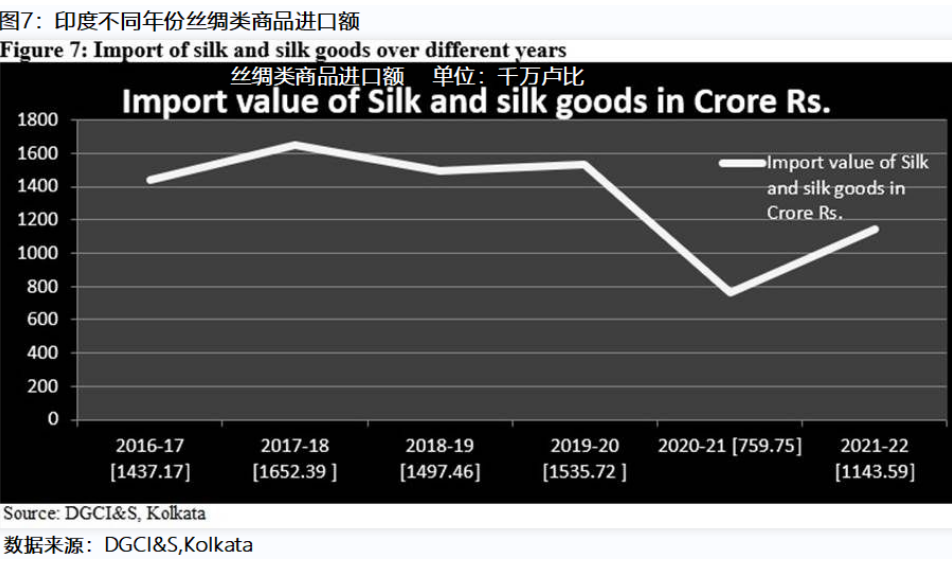As can be seen in Figure 7, the value of silk and silk goods imports is showing a decreasing trend. In 2017-18, the total import value was more than ?1,600 crore, which decreased to ?800 crore in 2020-21, which was mainly due to the pandemic situation. Import value reached to more than ?1,100 crore in 2021-22.

According to Figure 8, raw silk was the major import item having a share of 71.67 per cent in the year of 2021-22. Fabrics & made-ups was the second largest import value item having a share of 18.81 per cent, followed by silk yarn with 7.76 per cent share. Other silk items that were imported were readymade garments, silk carpets and silk waste.

Figure 9 explains the employment in silk industry from 2016-17 to 2021-22. In the year 2016-17, 85.10 lakh persons were engaged in the silk industry, where as the figure was 87.8 lakh persons in 2021-22. However, the number was highest at 94.3 lakh persons in 2019-20. Due to pandemic situation, the number of persons engaged in the silk industry decreased to 87.3 lakh in 2020-21.

Table 1 shows the variation in price of different types of raw silk from 2016-17 to 2021-22. The price of the most expensive raw silk muga (warp) was ?19,800 per kg in 2021-22, which is an increase of 66.6 per cent over the price in 2016-17. The price of mulberry raw silk price increased by 15.95 per cent to ?3,421 per kg in 2021-22 compared to 2016-17. Likewise, the price of eri (spun yarn) increased to ?2,900 per kg in 2021-22, an increase of 11.5 per cent compared to 2016-17.Challenges of Indian silk industryFollowing challenges are observed in Indian silk industry:
- Demand of silk products is decreasing in Europe and the US.
- Price of raw silk and fabric are rising.
- Competition with synthetic fibre industry is increasing.
- Competition is also observed with silk blended fibres.
- High quality raw silk availability is decreasing in the Indian market.
- There is competition with China in high quality raw silk and silk products.
Government initiatives for improvementThe ministry of textiles, Government of India, has been taking the following steps through the Central Silk Board (CSB).1. Silk Samagra is an initiative for development of sericulture in the country. The main objective of the scheme is to focus on improvement of quality and productivity of raw silk. It helps to reduce the import of raw silk.2. North Eastern Regional Textile Promotion scheme implemented 38 sericulture projects. The projects are applicable for Regional Development of North Eastern States.3. To improve quality and productivity of silkworm/host plant etc, Research and Development cell has been set up.4. Automatic reeling machine units have been established in specialized areas for production of International Standard Silk of 3A and 4A grades.5. National Rural Employment Guarantee Act and Rashtriya Krishi Vikash Yojana are being implemented to help silk farmers in rural areas.Integrated Scheme for Development of Silk Industries [ISDSI], was implemented by Govt. of India through the Central Silk Board (CSB). The aim of the scheme was to grant ?2161.68 crore for three years from 2017-18 to 2019-20 for overall development of silk industry in the country. The objective of the scheme was to improve quality and productivity along with R&D, training, transfer of technology, and information technology initiatives.7. The National Silk Policy 2020 is currently running. Its main features are:
- Improvement of seed organization.
- Improvement of coordination and market development.
- Implementing Quality Certification System [QCS] / Export brand promotion, and Technology upgradation.
- Upscaling of wet processing and weaving sections.
- Product diversification.
- Upscaling of mulberry reeling units.
- By-product utilization.
- Integrated farming systems.
- Effluent treatment system implementation.
- Information Technology interventions
- Export promotion of Indian silk products and raw silk.
- Brand promotion of Indian silk.
- Duty exemption on silk machinery.
- Foreign Direct Investment [FDI] in sericulture.
India is the second largest producer of raw silk in the world. The Indian silk industry employs around 9.76 million people. However, the industry faces many challenges, including price fluctuation of raw silk, and competition from synthetic fibers. The Government of India is currently implementing National Silk Policy 2020, which is helping the silk industry to overcome these challenges.
The article is from Industry Website, translated and edited by Esilk.net











